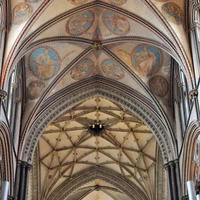2021-22 | 3D Modelling with Smartphones, Interior Spaces

'3D Modelling with smartphones, Interior Spaces'
Knowledge Exchange Fellow
Dr Ine Jacobs | School of Archaeology | University of Oxford
Partner Organisation
Virtual World Heritage Laboratory | Prof Bernard Frischer and Prof Gabriele Guidi
Digital 3D models are highly engaging. They have great potential for research, teaching and outreach. However, their creation typically requires expensive 3D scanners or DSLR cameras as well as specialist training. They therefore remain out of reach of most curators, researchers and heritage organisations. For this reason, in 2021, I collaborated with the Virtual World Heritage Laboratory to 1) test if the improved quality of camera phones could be harnessed to create high-quality digital 3D models, and 2) create a step-by-step protocol that would allow non-specialists to create their own models of small objects.
Our results exceeded expectations and confirmed the use of camera phones as a viable way forward. The resulting protocol is now being tested by non-specialist colleagues and volunteers and being refined. In this next phase, we want to apply the lessons learned (e.g. a selfie ring light is a gamechanger!) to create models of interior spaces in a similar simple and costefficient manner. I will again cooperate with the Virtual World Heritage Laboratory to examine whether phone cameras can give scientifically sound results when documenting buildings and, if so, create a workflow for optimal results that can be applied
widely. We will experiment both in the lab and in the field to develop the optimum methods for data capture; post-processing of data; storing, viewing, and publishing models.
The protocol will be applied in two diverse pilot projects: the Nigerian Rail Heritage project and the archaeological site of Aphrodisias. Because the protocol enables the simple and straightforward creation of high-quality, low-cost models, it will indeed be useful for a wide range of heritage organisations, e.g. to increase engagement both on site and on-line. We therefore intend to organise a multiday workshop to familiarize heritage specialists, enthusiasts, and societies in Oxford with the protocol for small objects as well as this new protocol for interior rooms.


